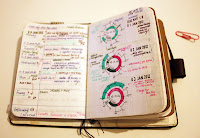Designing a planner is like designing a room in your house; it works to your needs. If your planner is a DIY type, this is very simple. But if you have a templated planner, designing what works for you can be challenging.
Different Layouts/styles of organization:
1)To-Do lists
2)Appointment style
3)Color coding
4)Chronodex/graphing
....and the list goes on!
1) To-Do Lists- If you're a straight forward thinker who doesn't care for colors and prefers a more simplistic style, to-do lists provide what you need. A to-do list provide a cut and clear list of priorities. (Be careful not to write them too long as this will become overwhelming- defeating the purpose of making a list in the first place).
2)Appointment Style- This style isn't for everyone. I personally don't have enough appointments/meetings during the day for this method to be of use to me. If you are a person who is schedule orientated, and busy with appointments, meetings, or other scheduled events, this method would be an easy way to lay it all out clearly.
3)Color coding- coding your priorities, events, or subjects into different colors, works for visual planners. If you find it enjoyable to see color in your events, this method is very effective. Color coding allows you to mix tasks together while still categorizing them by color.
4) Chronodex- a circular appointment method, while slightly unusual, could still be a potential method to utilize. If you like to see exactly where your time is going, while also incorporating a little bit of color, this method is your sweet spot. Basically, you divide your day (a circle) into appointments by time and if you want, color code that event, or write brief notes on the side.

The styles used to organize tasks ranges from simple and plain to wild and creative, it's just a matter of finding what works for how you think. Many people prefer their planners to be plain, others loud, and others in between. If you are having trouble finding what works best for you, try out a different method each day or week until you find that organizational sweet spot. Good luck!


No comments:
Post a Comment